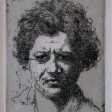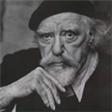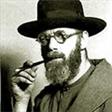1905 -1908
Epstein moved into 219 Stanhope Street, London, where he lived and worked. In his first year in London he was introduced to George Bernard Shaw and Robert Ross, as well as the artists Augustus John, Francis Dodd, William Rotherstein and James Muirhead Bone.He returned briefly to New York in 1906 using a ticket sent by his family. However, he only stayed two weeks before returning to London and moving into Stamford Bridge Studios in Fulham with Peggy. They married on 13 November 1906. In the same month Epstein exhibited his first work in England, Portrait of Konhong-Sara, an oil painting.
In 1907 Epstein moved his studio to 72 Cheyne Walk, Chelsea and began work on his first major public commission. The architect Charles Holden was constructing a new building in the Strand for the British Medical Association. Holden had visited Epstein in his studio and seen work on Girl with a Dove. He commissioned Epstein to carve eighteen over life size figures to decorate the building. It may not just have been admiration for Epstein’s work that resulted in the commission – the fee was very low (less than £100 per figure) which would have deterred more established sculptors.
Epstein carved a set of male and female nudes, which were intended as “noble and heroic forms to express in sculpture the great primal acts of man and woman.” These figures were gradually revealed to the public as the scaffolding was removed in June and July 1908. The uncovering of the first five statues prompted an article in the Evening Standard on 19 June castigating the exposure of nudity to the public gaze when it properly belonged only in art galleries. On the 11 July the British Medical Journal reported that “the whole Strand opposite was packed with people, most of them girls and young men, all staring up at the statues.” The figure which drew the most outrage was Maternity, a realistic depiction of a pregnant woman. Demands were made for the removal of the statues, but Epstein was supported by artists, clergymen and the director of the National Gallery, which enabled the BMA to resist these demands.
After this contentious public exposure, Epstein returned to figure studies and began to receive portrait commissions. In 1908 he was commissioned by Robert Ross to carve the tomb of Oscar Wilde, and in the same year he met Eric Gill.





